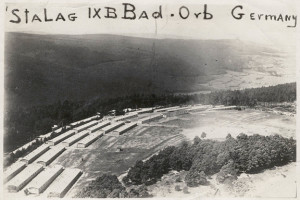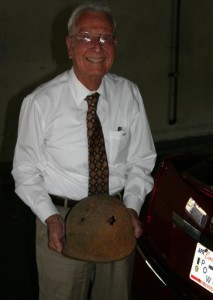Use controls above or click here to open this Hometown Heroes podcast in a new window
Thousands crowded onto the National Mall in Washington, D.C. on May 8, 2015 to mark the 70th Anniversary of V-E Day, watching as dozens of vintage World War II airplanes flew in a parade of symbolic formations, representing key moments from along the path to the eventual Allied victory. CLICK HERE for a thorough article about the event, complete with a gallery of photos and video.

Episode #366 of Hometown Heroes includes 70-year-old newsreel audio marking that historic day, and features the story of one of thousands of prisoners of war who may have died in captivity if America and its allies had not pressed on to victory. Most German POW camps were liberated in the month leading up to V-E Day, but had the Nazi regime prevailed, the future of those prisoners was uncertain at best.

One of those camps was Stalag IX-B in Bad Orb, Germany, where a young man named Glenn Schmidt spent most of his time in captivity. This edition of Hometown Heroes follows Glenn’s story from the time a 17-year-old high school senior in Reedley, CA found out that the Japanese had bombed Pearl Harbor. Ten months later, Glenn enlisted in the Army Air Corps. He became a Link Trainer instructor before joining the Army Specialized Training Program (ASTP), which allowed him to study engineering at Illinois College in Jacksonville, IL. After heavy losses in Europe presented the need for more infantry soldiers, the ASTP was disbanded, and Glenn was assigned to the 42nd Infantry Division.

Schmidt left behind a wife and newborn son as he headed overseas as a Browning Automatic Rifle (BAR) man with the 242nd Infantry Regiment. He landed in France December 8, 1944, and was taken by train to Strasbourg, France, where he experienced his first taste of combat. It was in that area a month later that Glenn experienced his closest call. At about 9 p.m. on January 8, 1945, Glenn and about 10 other American soldiers were crawling through the snow in the hopes of establishing a listening post when the Germans opened fire. “Bullets were flying all around us,” you’ll hear Schmidt remember. He watched the man in front of him killed instantly by enemy machine gun fire. When two Germans set up a machine gun on a bridge in the distance, Glenn used his BAR to take them out. More enemy soldiers took over the machine gun and set it on automatic, sending bullets in every direction. Listen to Hometown Heroes to find out how Glenn had his helmet knocked off, leaving entry and exit holes in that headgear, and how he was eventually captured in a pillbox with no ammunition left.

You’ll also hear him explain why a letter from his father, quoting a particular verse of scripture (Psalm 91:7) had a significant impact on him, and how his time as a prisoner of war became more and more desperate by the day. When he walked into Stalag IX-B, a guard told him he would live for five to seven months on the amount of food he’d be given there. “Those weren’t very encouraging words,” Glenn remembers. “But it proved to be quite true.” Starvation, freezing conditions, and at times brutal treatment from their captors caused many of the prisoners to lose hope, but fellow P.O.W. Bill Paschal says Schmidt was a “lifesaver.” Listen to Hometown Heroes to hear Paschal surprise Schmidt by calling into the show from Kansas, and explaining what Glenn did to boost the spirits of the other prisoners. April 2, 1945 would be a “day of liberation, and a day of elation,” Schmidt remembers. 145 pounds when he was captured, Glenn weighed just 92 pounds when he tasted freedom again, so weak he could barely walk.

You can read his P.O.W. diary here, and in 2013, Glenn teamed with two fellow prisoners to publish an account of their experiences. Captured in Hatten: a story of survival is available in paperback and e-book. The book’s front cover shows Glenn holding his World War II steel helmet, but he left that helmet behind in a German pillbox when he was captured in 1945. In 1962, while serving with the Air Force near Strasbourg, he took his two sons to the area where he had been captured 17 years earlier. Despite warnings around the long-abandoned bunkers, his sons went underground into the very pillbox where Glenn’s life had taken a dramatic turn. When they re-emerged, one was carrying a hand grenade, and the other had a steel helmet with two holes in it. You’ll hear Glenn explain how he knew the helmet was his, and share what the saying “freedom is not free” means to him. “I am deeply gratified for my God, and my country,” he concludes. Glenn, thank you for your service, and for sharing your incredible story with us.
—Paul Loeffler

V-E Day 70th Anniversary

Archive
- October 2024
- September 2024
- August 2024
- July 2024
- June 2024
- May 2024
- April 2024
- March 2024
- February 2024
- January 2024
- December 2023
- November 2023
- October 2023
- September 2023
- August 2023
- July 2023
- June 2023
- May 2023
- April 2023
- March 2023
- February 2023
- January 2023
- December 2022
- November 2022
- October 2022
- September 2022
- August 2022
- July 2022
- June 2022
- May 2022
- April 2022
- March 2022
- February 2022
- January 2022
- December 2021
- November 2021
- October 2021
- September 2021
- August 2021
- July 2021
- June 2021
- May 2021
- April 2021
- March 2021
- February 2021
- January 2021
- December 2020
- November 2020
- October 2020
- September 2020
- August 2020
- July 2020
- June 2020
- May 2020
- April 2020
- March 2020
- February 2020
- January 2020
- December 2019
- November 2019
- October 2019
- September 2019
- August 2019
- July 2019
- June 2019
- May 2019
- April 2019
- March 2019
- February 2019
- January 2019
- December 2018
- November 2018
- October 2018
- September 2018
- August 2018
- July 2018
- June 2018
- May 2018
- April 2018
- March 2018
- February 2018
- January 2018
- December 2017
- November 2017
- October 2017
- September 2017
- August 2017
- July 2017
- June 2017
- May 2017
- April 2017
- March 2017
- February 2017
- January 2017
- December 2016
- November 2016
- October 2016
- September 2016
- August 2016
- July 2016
- June 2016
- May 2016
- April 2016
- March 2016
- February 2016
- January 2016
- December 2015
- November 2015
- October 2015
- September 2015
- August 2015
- July 2015
- June 2015
- May 2015
- April 2015
- March 2015
- February 2015
- January 2015
- December 2014
- November 2014
- October 2014
- September 2014
- August 2014
- July 2014
- June 2014
- May 2014
- April 2014
- March 2014
- February 2014
- October 2013
- September 2013
- August 2013
- July 2013
- June 2013
- May 2013
- March 2013
- February 2013
- January 2013
- December 2012
- August 2012
- July 2012
- June 2012
- March 2012
- February 2012
- January 2012
- December 2011
- April 2011
- January 2011
- December 2010
- November 2010
- October 2010
- September 2010
- August 2010
- July 2010
- February 2010
- January 2010
- October 2009
- September 2009
- August 2009
- July 2009
- April 2009
- March 2009
- October 2008
- September 2008
- August 2008
- May 2008
Categories
- Alabama
- Alaska
- All Episodes
- Arizona
- Arkansas
- California
- Colorado
- Connecticut
- Florida
- Georgia
- Hawaii
- Idaho
- Illinois
- Indiana
- Iowa
- Kansas
- Kentucky
- Louisana
- Maine
- Maryland
- Massachusetts
- Michigan
- Minnesota
- Mississippi
- Missouri
- Montana
- Nebraska
- Nevada
- New Hampshire
- New Jersey
- New Mexico
- New York
- North Carolina
- North Dakota
- Ohio
- Oklahoma
- Oregon
- Pennsylvania
- Rhode Island
- South Carolina
- South Dakota
- Tennessee
- Texas
- Utah
- Vermont
- Virginia
- Washington
- Washington DC
- West Virginia
- Wisconsin
- Wyoming
Recent Posts
Tags
1st Infantry Division 2nd Reconnaissance Squadron 12th Bomb Group 18th Infantry Regiment 40th Infantry Division 90th Infantry Division Albert Flores Bakersfield Baseball Hall of Fame Battle of the Bulge Bronze Star China Burma India Columbia D-Day Dick Lyon Dog Tag Don Westfahl Fort Pierce Fullerton Guadalcanal Guskhara Irving Mann Jackie Robinson Leyte Luzon malaria Minter Field Navy SEAL New Britain North Africa Oceanside Okeene Oklahoma Pasadena Philippines Roger Jamison Roger Maraist Scouts & Raiders Shafter Stockton Tunisia U.S. Army Visalia World War II Yale
Leave a Reply